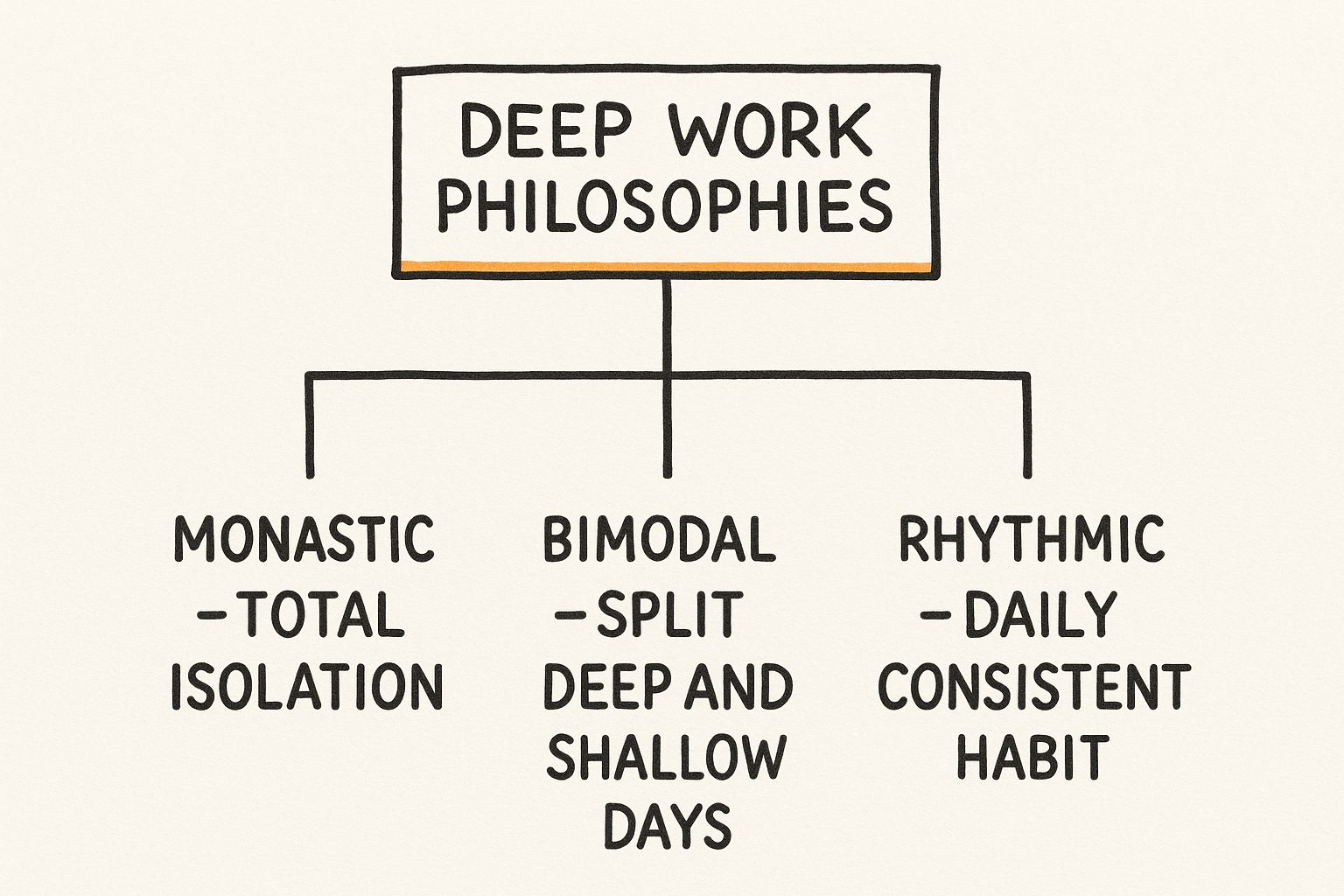Feel like you're busy all day but not making progress? Drowning in pings, emails, and meetings, only to wonder where the time went? You’re not alone. This guide is for anyone who wants to trade reactive busywork for calm, focused accomplishment. We'll show you not just what deep work is, but how to make it a practical, sustainable part of your daily routine.
Defining Deep Work in a Distracted World

So, what exactly is deep work? Coined by author Cal Newport, it’s the ability to focus without distraction on a cognitively demanding task. It’s the state of flow where you produce your best, most valuable output—solving complex problems, writing a difficult strategy document, or coding a challenging new feature. In a world that rewards constant connectivity, deep work is the rare skill that allows you to create real value.
The opposite is “shallow work”: all the logistical, non-demanding tasks often done while distracted. Think answering routine emails, scheduling meetings, or sorting files. While some shallow work is necessary, a day dominated by it leaves you feeling drained but unaccomplished. The modern workday, with its endless notifications, pulls us into this shallow, reactive state. Deep work is the antidote. It’s about intentionally carving out time to concentrate on what truly matters.
The True Cost of Constant Digital Interruptions
The modern workday often feels like a battle against a rising tide of notifications. Each one seems small—a quick Slack message, a brief email scan—but they carry a massive hidden cost. They pull us out of deep, meaningful work and trap us in a state of constant reaction.
This isn't just about losing a few minutes; it's about fracturing your attention. Every time you switch tasks, you leave a piece of your focus behind. This phenomenon, known as attention residue, means that even when you return to your main task, part of your brain is still thinking about the interruption. These tiny mental shifts add up, slowly chipping away at your ability to think deeply. For more on this, check out our complete guide on the hidden productivity costs of context switching.
Principles for Practicing Deep Work
Getting started with deep work isn't about radically overhauling your life. It's about adopting a few calm, practical principles that help you protect your most valuable resource: your attention.
Find a philosophy that fits your life
There's no single "right" way to do deep work. Cal Newport outlines four different philosophies, from the hardcore "Monastic" approach (eliminating shallow work entirely) to the flexible "Journalistic" method (diving into deep work whenever an opportunity arises).
For most people, the Rhythmic philosophy is the most practical. Instead of walling off entire days, you build a consistent, daily habit. This could be as simple as scheduling a 90-minute focus block every morning, no exceptions. The power is in the consistency. It turns deep work from a rare, heroic effort into a reliable, everyday practice. You can discover more insights about deep work on proofhub.com to find the right rhythm for you.
Embrace "forced thoughtfulness"
The key to deep work isn’t just finding time; it’s being intentional with that time. At Sunsama, we call this "forced thoughtfulness." It’s the simple act of pausing before you dive in to ask, "What is the most important thing I can do right now?"
This habit of daily planning helps you distinguish between what’s urgent and what’s truly important. By consciously choosing your focus, you shift from a reactive mode—letting your inbox run your day—to a proactive one. This thoughtful approach ensures your deep work sessions are spent on tasks that actually move the needle.

Protect your focus, not just your time
Blocking time on your calendar is a great start, but it's not enough if you’re still getting bombarded with notifications. True deep work requires creating a bubble of focus. This means eliminating both external distractions (like pings and pop-ups) and internal ones (the urge to check your email).
This is why building a pre-session ritual is so important. It’s a series of small actions—like closing irrelevant tabs, turning off notifications, and setting your Slack status—that signal to your brain and your colleagues that it's time to concentrate. This protects your attention, allowing you to fully immerse yourself in the task at hand. Check out these practical email management tips to reduce distractions to get started.
How to Plan Your First Deep Work Session: A Step-by-Step Guide
Theory is one thing, but practice is where the magic happens. Let's walk through a calm, step-by-step process to plan and execute your first deep work session. Don't aim for perfection; aim for progress.
1. Triage and identify your single most important task.
- What to do: Look at your to-do list and pick one high-impact task.
- How to do it: Before your day begins, review your tasks and ask, "If I could only get one thing done today, what would make the biggest impact?" This shouldn't be a vague goal like "work on report," but something specific: "draft the introduction for the Q3 report."
2. Timebox it on your calendar.
- What to do: Schedule a realistic block of time for your chosen task (preferably using Sunsama)
- How to do it: Find a 60-90 minute slot on your calendar and block it out. Treat this appointment with yourself as seriously as you would a client meeting. This makes your intention visible to yourself and your colleagues. For a detailed guide, see how time blocking can transform your productivity.
- Try it in Sunsama: Drag your most important task from your list directly onto your calendar to create a timeboxed plan for the day.
3. Prepare your environment.
- What to do: Minimize physical and digital distractions before you begin.
- How to do it: Clear your desk of clutter, close all irrelevant tabs and apps, and put your phone on silent and out of sight. This small ritual signals to your brain that it’s time to focus.
Pro Tip: Set your status in Slack or Teams to "Focusing" with a clear end time (e.g., "Deep work until 11 AM"). This proactively manages colleague expectations and reduces interruptions without you having to say a word.
4. Start the session with a timer.
- What to do: Use a timer to define the start and end of your session.
- How to do it: This creates a container for your focus. Knowing there’s a clear finish line makes it easier to resist the urge to check your email or get distracted. It’s a simple commitment: "For the next 75 minutes, this is all I'm doing."
- Try it in Sunsama: Start Focus Mode for your task. It pulls up a timer, hides your other tasks, and can even auto-update your Slack status for you.
5. Conclude with a shutdown ritual.
- What to do: End your session with a consistent routine that helps you disconnect.
- How to do it: When the timer goes off, take two minutes to review your progress, jot down the next steps, and close all your work tabs. This creates a clean break, preventing work thoughts from lingering and helping you truly recharge.
Is Deep Work Always the Answer? (A Nuanced Take)
While deep work is powerful, it's not a silver bullet for every challenge. Insisting on four hours of uninterrupted focus every day can be unrealistic, especially for managers or those in collaborative roles where responsiveness is key. The goal isn't to become a hermit.
True productivity comes from balance. It’s about being intentional with your energy—knowing when to dive deep and when to engage in collaborative, shallow work. A day might include a 90-minute deep work block for strategy, followed by a series of 30-minute meetings and quick check-ins. Both have their place.
The real aim is to be the architect of your day, not a victim of it. By thoughtfully planning your time, you ensure that the necessary shallow work doesn't completely crowd out the deep, meaningful work that drives real progress and fulfillment.
How We Practice Deep Work at Sunsama
At Sunsama, our entire tool is built around the philosophy of calm, intentional work. Our co-founder, Ashutosh, designed his workflow to bake in deep work without getting disconnected from the team.
It follows a simple loop: Triage → Plan → Focus.
- Triage: He starts the day by pulling tasks from email, Slack, and project management tools into his Sunsama column. This gets everything out of his inbox and into one place.
- Plan: Next, he timeboxes his 1-3 most important tasks on his calendar for the day, usually scheduling his deepest work for the morning. This daily planning ritual takes about 15 minutes but sets the intention for the entire day.
- Focus: When it's time to start a deep work task, he uses Sunsama's Focus Mode. This syncs his Slack status to "Focusing," turns on a timer, and minimizes distractions, creating an instant focus environment.
This workflow isn't about rigid perfection; it's a flexible ritual that ensures deep work happens by design, not by chance. For more on this, check out our guide on the rhythm of attention.
Overcoming Common Barriers to Deep Work
Starting a deep work practice is one thing; sticking with it is another. Here’s how to navigate the most common hurdles with a calm, practical approach.
What if my boss expects instant replies?
This is about managing expectations. The key is proactive communication. Let your boss and team know your plan. A simple message like, “I’m blocking off 9-10:30 AM for focused work on Project X to hit our deadline. I'll be available for urgent needs via phone call, otherwise I'll reply after 10:30,” works wonders. This shows you’re prioritizing important work, not ignoring them. You can also discover more insights about these workplace productivity challenges to share with your team.
What if my own mind is the biggest distraction?
This is completely normal. The urge to check just one more thing is powerful. The trick is to add a little friction to your distractions. Use a website blocker during your focus sessions. Put your phone in another room. The goal isn't to achieve perfect willpower but to create an environment where the most compelling thing to do is the deep work itself. Each time you resist the urge, you strengthen your "focus muscle."
How can I do deep work in an open office?
It takes a bit more effort, but it's possible. Noise-canceling headphones are your best friend. They create an immediate auditory bubble. Also, try to use your environment strategically. Book a small meeting room for an hour, or find a quiet corner of the office. Communicating with your immediate neighbors—"Hey, I'm going heads-down for an hour"—can also help create a small zone of respect for your focus. Ultimately, deep work is about finding and protecting your state of flow. To master this, you can learn more about getting into a flow state in our detailed guide.
Start Your Deep Work Practice Today
Moving from a reactive to an intentional workday is a journey, not an overnight switch. The goal isn't perfection; it's about making small, consistent efforts to reclaim your focus. By following the steps in this guide, you can start building a calmer, more sustainable relationship with your work, one focused session at a time. You'll not only produce better work but also end your days feeling accomplished instead of just busy.
Ready to build a calmer, more focused workday? Try Sunsama free for 14 days and see how daily planning and Focus Mode can help you make space for the work that matters.











